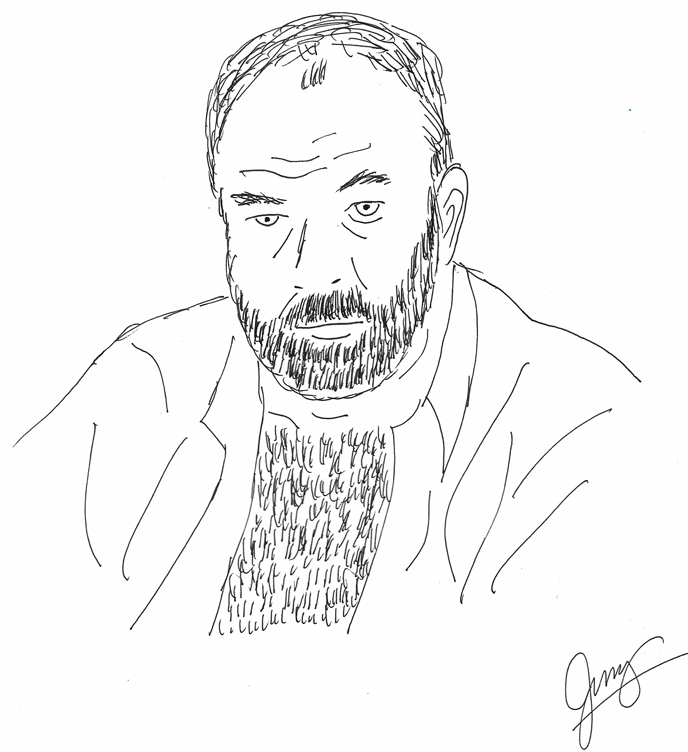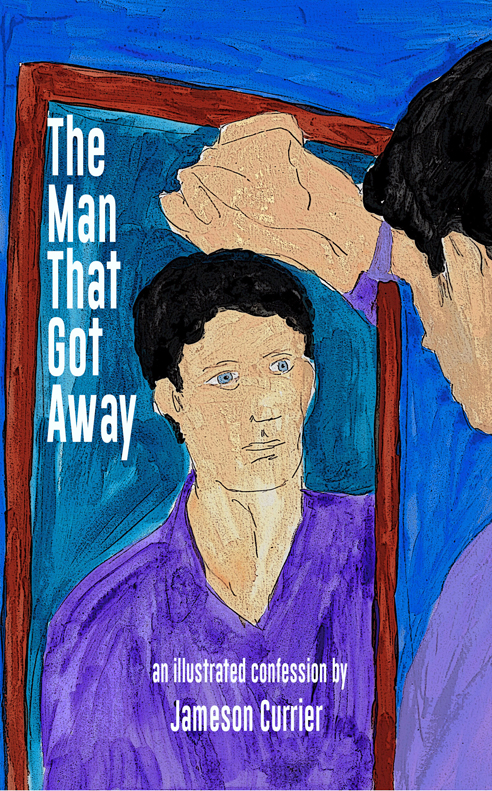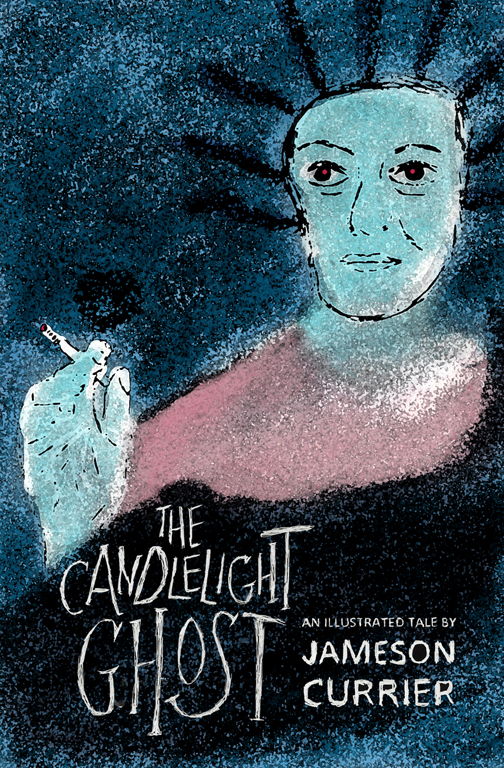
sketch of Arch Brown
by Jameson Currier
ink on paper
20200525008
Discovering Arch Brown
by Jameson Currier
Foreword to A Pornographer, a memoir by Arch Brown
This memoir was discovered in 2012 in the months after Arch Brown’s death at the age of seventy-six, when James Waller, Arch’s friend and literary executor, was cleaning out Arch’s home in Palm Springs, California, and locating documents, photos, and other materials to be archived as a record of Arch’s rich and varied literary, theatrical, and film career. In 2004, Arch had self-published a few manuscripts—10 Men, 20 Years, a cycle of ten short plays based on the gay men in his life; Love Plays: Four Comedies for the Stage, a collection of plays that included The Bottom Drawer, Living Arrangements, Pantheon, and Brut Farce; and The Land of Rodina, a comic novel about a gay man thrust back to his midwestern roots when he attends a family funeral. Arch had distributed copies of these books to his friends and the board members of the Arch and Bruce Brown Foundation, which Arch had created in 1994 to award production grants to LGBT theaters and writing competition grants to LGBT authors. I had been a fortunate recipient of a grant in 1997 for my first novel, Where the Rainbow Ends, and the following year Arch had asked me to join the foundation’s board. When I attended the foundation’s board meeting in 2004, I did not know that Arch had been diagnosed with cancer; I remember asking him why he had self-published these three books, and his sharp, curt reply was, “For posterity!”
At the foundation board meeting in New York City in November 2012, James Waller mentioned finding an unpublished manuscript in Arch’s belongings in California, offering only the slightest details, including the title and the topic, which were one and the same: A Pornographer. This was a memoir Arch had written about his directorial work in adult films in the mid-1960s through the early 1970s. Several things went through my mind at once: Why hadn’t Arch published this manuscript when he was self-publishing his other work in 2004? Could this be something I might consider publishing for Chelsea Station Editions as a way of posthumously thanking Arch and the foundation for giving me a career boost in 1997 when I desperately needed one? And why had I neglected to learn more about Arch’s early career as a writer and director of gay sex films?
I asked to read the manuscript. James mentioned it was in a fragile state—the typewritten pages were disintegrating—but he would arrange to have a photocopy made for archival purposes and the manuscript retyped.
I didn’t receive the typescript until 2015, but I read it with interest and immediately realized it was something entirely unexpected as well as being more than a memoir. It not only captured a changing moment in the sexual culture of the country pre- and post-Stonewall, it also revealed the underlying psychology of how that change occurred on an individual, personal level, not only for its author, but for those depicted within its pages. This was a distinct and unique historical manuscript.
Up to that point, I had never seen any of Arch’s “pornographic” films, so I had no reference material in mind when I read the manuscript. In many ways that worked to my advantage and was another reason why when I had finished reading the manuscript I felt compelled to publish it. In A Pornographer, Arch recounts his interviews with many of the men and women who wanted to star in his sex films—some who did, others who did not. He is all at once receptionist, gopher, casting agent, writer, director, stagehand, cameraman, talent scout, friend, and on-the-spot psychiatrist. You don’t need to have viewed any of Arch’s sex films to appreciate this memoir. In fact, Arch goes out of his way not to mention the titles of any of his films and he only identifies his cast of characters by fictional first names. The result is that A Pornographer is a historical gem, an unexpectedly insightful psychological view of the performers who were drawn to having sex in front of a camera and how and why audiences responded to them.
Arch’s porn career stretched from 1967 to 1985, but my estimation is that he began writing this memoir around early 1974, following the release of The Night Before, his breakout feature-length film success. I date the writing of the manuscript from several events: In the memoir, Arch notes that he has made thirty films and references the success of The Night Before, not by name, of course, but by writing, “A few months later a film that I had made was the twelfth largest grossing film for that week in the country according to Variety.” In an article published in 1973 shortly after the release of The Night Before, the writer noted that The Night Before was Arch’s twenty-fifth film. It’s impossible to estimate Arch’s total film output because he uses the term “film” to denote movies of any length, including those with a running time as short as eight minutes, generally referred to as “loops,” or today called a “short.” Many of Arch’s early loops were also later released bundled together as anthology features or in other cases Arch had written and filmed a subsequent narrative frame to combine them into a longer feature for theatrical release. Arch also writes in this manuscript of being in a twelve-year relationship with “Brew,” a nickname for his longtime partner Bruce Brown. Arch and Bruce met during Labor Day weekend in 1965 at a Coney Island bathhouse, so a twelfth year would occur around 1977, which I estimate is the year Arch began to submit this manuscript to publishers. After the success of The Night Before, Arch also worked with several actors who became legendary personalities recognized for their performances in gay male adult films, among them Jack Wrangler, Scorpio, Casey Donovan, and Justin Thyme, and later in his adult film career, he also worked as a cinematographer on several films produced and directed by Christopher Rage. In this manuscript, there are no anecdotes or recollections of those actors or films.
The publication of A Pornographer has also cast me as an accidental historian. When I made the decision to publish the memoir, it was always my intent to include some additional material, though I knew I wanted to avoid an academic or pompous assessment or reassessment of Arch’s film or theatrical career. Arch preferred to avoid this kind of examination. In these pages he writes, “I have never intended my films to be judged as masterworks of cinematic art. I prefer they be judged as good or bad sex films; if something else in them appeals to the viewer, fine, but to discuss my works totally as some sort of grand statement seems a bit silly. But there is a statement there and I guess for those that want to see it and discuss, I am pleased they do.”
I did, however, want to include an appendix including Arch’s filmography and, if possible, quotes from reviews his films received at the time of their release. My goal of compiling a complete filmography proved to be a more difficult task than I expected. As an example, A Pornographer provides details of many female performers who appeared in Arch’s early short films and Arch describes filming many heterosexual couples having sex, though unlike Arch’s gay shorts and longer feature films, these productions remain missing or unidentified and haven’t garnered the attention that archivists have directed at early gay pornographic films. In September 2016, I made a trip to Ithaca, New York, where Arch’s papers are now housed in the Human Sexuality Collection at the Division of Rare and Manuscript Collections at the Cornell University Library. Looking through the archive, I found reference to only one film with female performers in the cast, a movie called The Country featuring gay and heterosexual couples, which appears to have been filmed outside New York City, post-1972, and perhaps after the writing of A Pornographer. As James Waller notes in his fascinating Afterword, while sorting through Arch’s possessions to archive, he found little documentation of Arch’s porn film career except for production stills and a scrapbook of clippings and reviews. This scrapbook provided a primary source of the critical response Arch’s films received, and also served as a key to understanding the chronology of his films.
As a pornographer, Arch always worked “for hire,” writing, directing, and filming for a flat fee. Unlike other early sex filmmakers, he did not own or produce or distribute his films, and this has both helped and hindered the archiving of his films, because he did not possess final reels of them. Arch’s early gay male sex loops were shown in a private movie club in New York City called Cinema 7, an organization that charged members a three dollar admission fee to watch gay porn films. In January 1970, Cinema 7 was raided by the police and several customers, a ticket taker, and the club owner were arrested. Several sources note that many of Arch’s films were confiscated, though one of the projectionists saved some of Arch’s loops; these saved shorts were later released together as the feature-length Five Hard Pieces.
Many of Arch’s gay sex films can still be found and viewed on the Internet, which is where and how I discovered and viewed them. I hope readers will use this book as their own stepping stone to such an adventure. As one critic of the day noted, “there is something for every sexual kink” in Arch’s oeuvre. What stands out importantly to me, however, and what Arch himself notes in a summation of his early films, is his focus on romance and relationships. “I tend to be an incorrigible romantic in many ways and the endings of my films seldom are negative and are usually very positive and possibly happy,” he writes in A Pornographer. “Relationships started in films tend not to end with the film but have a chance of succeeding on a long-term basis.”
Relationships, of course, are varied and complex and each partner will have their own distinct view. James Waller’s Afterword is as memorable as Arch’s memoir, because James examines, through a prism of time and distance, his personal relationship with Arch. It is a multifaceted view of a multifaceted man, with a bittersweet ending that Arch might have orchestrated himself.
I first knew Arch as a philanthropist and a benefactor, then later as a playwright and a generous friend, and now as a filmmaker and an author. And I am grateful to be able to share my admiration of his life and career with audiences both new and old.
Jameson Currier
September 2017
____________________________________
“Discovering Arch Brown” was published as the foreword to Arch Brown’s memoir, A Pornographer (Chelsea Station Editions, 2018).








